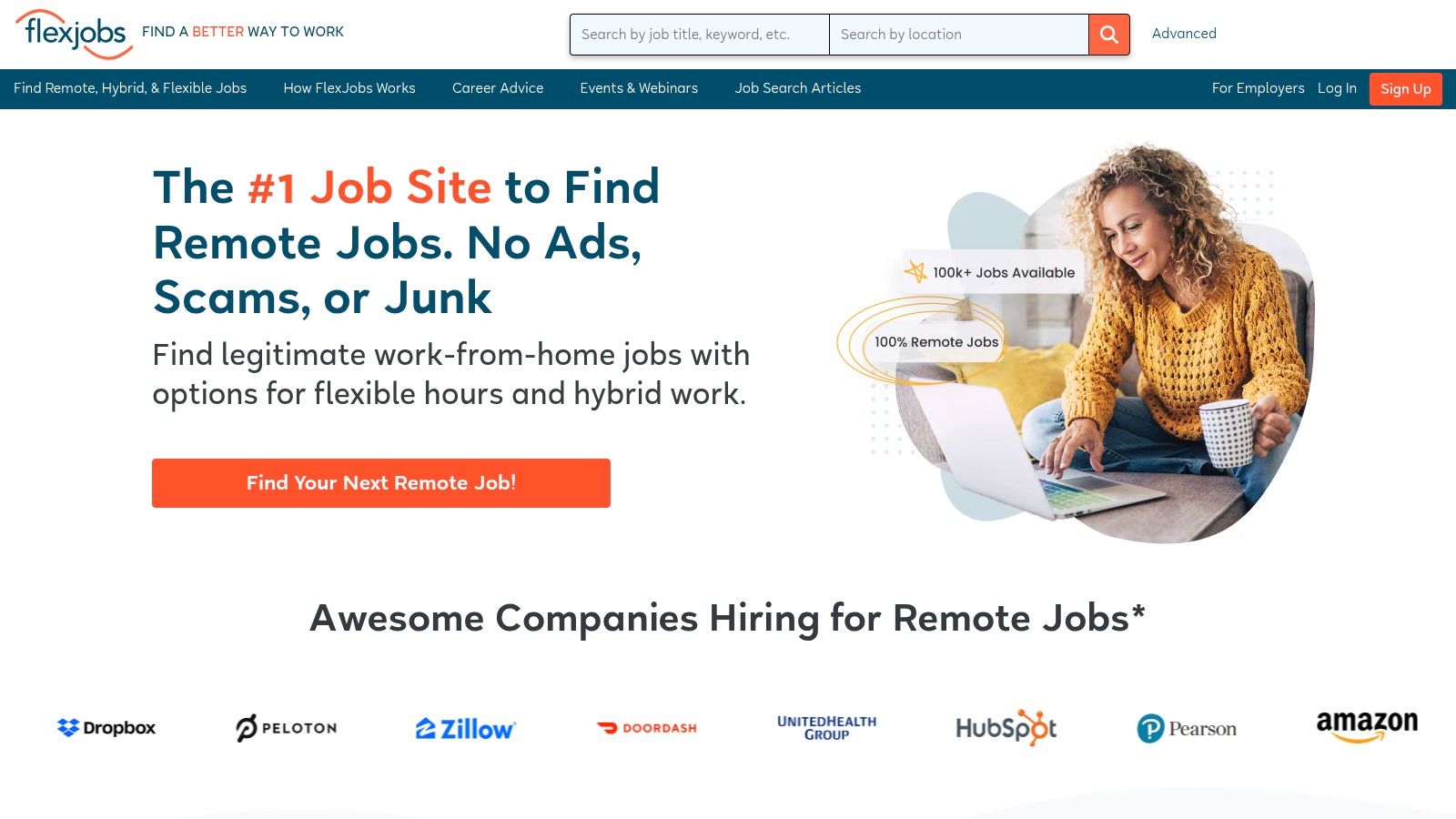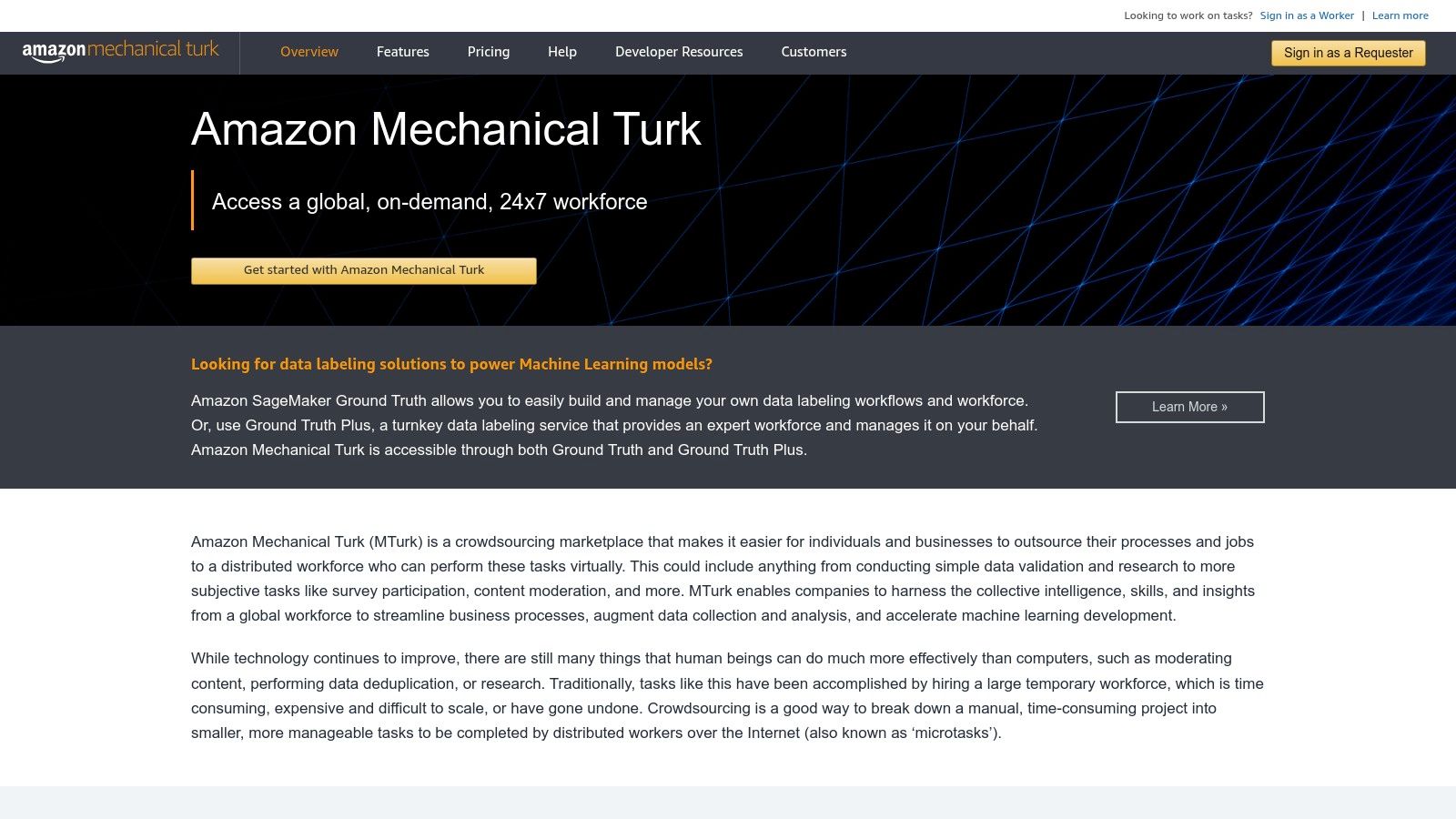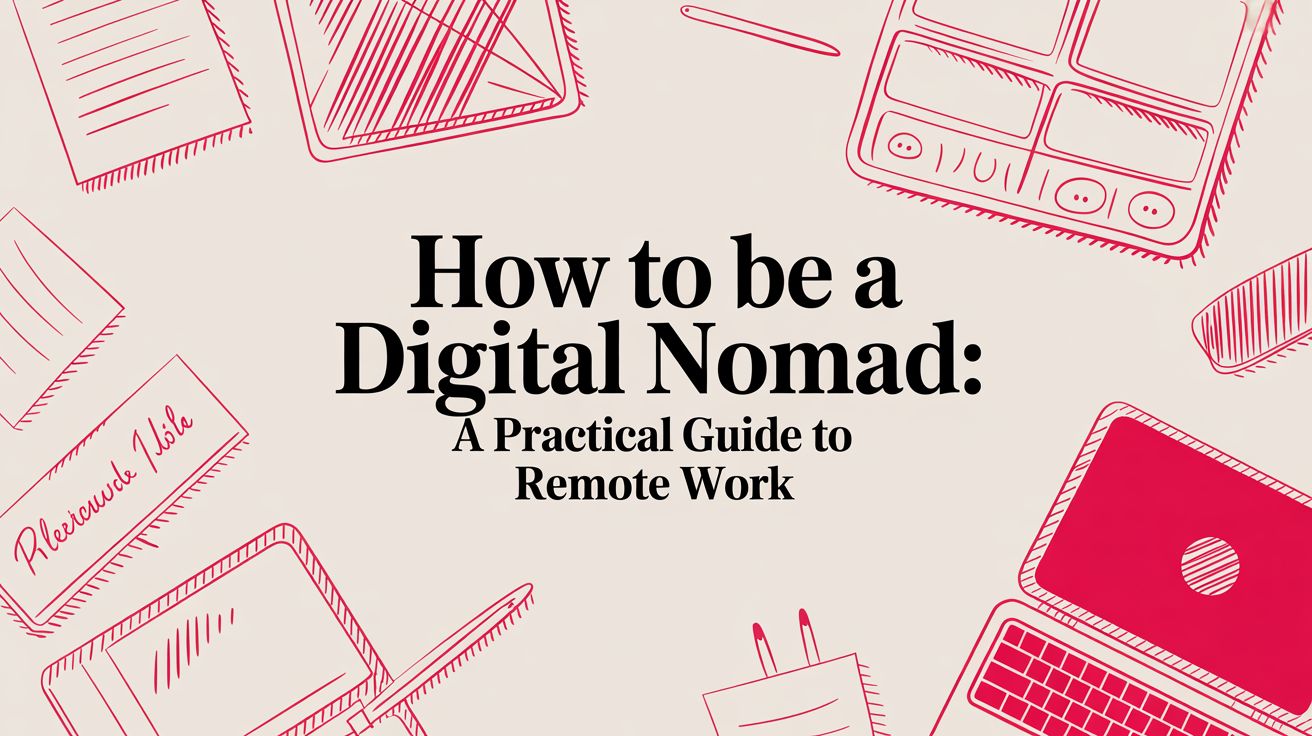7 of the Easiest Remote Jobs to Get Hired For in 2025
Max
The remote work landscape is no longer a niche market; it’s a global standard. While many high-paying tech roles dominate headlines, a wealth of accessible opportunities exists for those just starting or looking for a low-barrier entry point. The key is knowing where to look and what roles offer the quickest path to a paycheck without years of specialized experience. This guide demystifies the process, highlighting some of the genuinely easiest remote jobs to get right now.
Forget the endless searching through competitive listings that demand extensive qualifications. We’ve curated a list of roles that prioritize accessible skills and straightforward application processes. For each job, we’ll break down exactly what the position entails, the skills you likely already possess, and what you can expect to earn.
To make your job hunt even more effective, we will also pinpoint the best platforms to find these roles, from Indeed and LinkedIn Jobs to specialized sites like FlexJobs and freelance marketplaces such as Upwork. Each recommendation includes practical, actionable steps to help you secure the position. Consider this your direct route to finding and landing your first, or next, remote job. Your remote career starts here.
1. Virtual Assistant: The Organizational Backbone of Remote Businesses
A Virtual Assistant (VA) is a remote professional providing administrative, technical, or creative assistance to clients. Think of it as the evolution of the traditional office assistant, perfectly adapted for the digital age. VAs are the organizational powerhouses behind many successful entrepreneurs and small businesses, handling the crucial tasks that keep operations running smoothly.
This role is frequently highlighted as one of the easiest remote jobs to get because the barrier to entry is relatively low. The core skills required are often transferable from previous office, retail, or customer service experience. If you are organized, a good communicator, and tech-savvy, you already have the foundational skills to succeed.
What You’ll Do
The tasks of a Virtual Assistant are incredibly diverse and can be tailored to your skillset. Common responsibilities include:
- Administrative Support: Managing calendars, scheduling appointments, organizing files, and handling data entry.
- Communication Management: Filtering and responding to emails, managing customer service inquiries, and making phone calls.
- Content & Social Media: Scheduling social media posts, basic graphic design using tools like Canva, and proofreading blog posts.
- Bookkeeping & Finance: Basic invoicing, tracking expenses, and managing accounts payable.
Key Skills & Average Pay
To land a VA role, you don’t need a specialized degree. Instead, focus on demonstrating proficiency in these areas:
| Skill Category | Examples |
|---|---|
| Organizational Tools | Google Workspace (Docs, Sheets, Calendar), Trello, Asana |
| Communication | Professional email etiquette, active listening, clear writing |
| Tech Literacy | Fast typing speed, familiarity with cloud storage, video conferencing |
Average Pay: Entry-level VAs can expect to earn between $15 to $25 per hour. With specialized skills like advanced bookkeeping or social media marketing, experienced VAs can command rates of $50 per hour or more.
Pro Tip: Create a simple online portfolio showcasing your skills. Include a sample calendar you organized, a professional email template you wrote, or a mock social media schedule. This tangible proof is far more convincing to potential clients than just a resume.
2. Indeed: The Global Hub for Entry-Level Remote Roles
Indeed is less a specific job role and more a massive search engine where you can find countless entry-level remote positions. As one of the largest job aggregators in the world, it pulls listings from thousands of company career pages and job boards, making it an essential first stop for anyone looking for accessible remote work.
This platform is a powerful tool for finding the easiest remote jobs to get because of its sheer volume and powerful filtering capabilities. You can specifically search for “remote” and “entry-level” positions, instantly narrowing down a vast sea of opportunities to those that don’t require specialized degrees or years of experience. For many, Indeed is the gateway to their first remote job.
What You’ll Find
Indeed is a treasure trove for accessible remote jobs across various industries. The most common entry-level remote roles you’ll discover include:
- Customer Service: Answering customer inquiries via phone, email, or chat. Understanding the key responsibilities and skills of a customer support representative can give you a significant advantage.
- Data Entry: Inputting and verifying data in spreadsheets and databases.
- Virtual Assistance: Performing administrative tasks for businesses and entrepreneurs.
- Sales Support: Assisting sales teams with lead qualification and administrative duties.
Key Features & Job Hunting Strategy
To maximize your success on Indeed, leverage its built-in tools. It’s completely free for job seekers.
| Feature | How to Use It Effectively |
|---|---|
| Robust Filters | Use “Remote” for location and filter by “Entry Level” experience. |
| Saved Searches & Alerts | Set up email alerts for your ideal job search to apply early. |
| Company Reviews | Research potential employers to avoid scams and find good fits. |
| Easy Apply | Upload your resume to apply to multiple suitable jobs quickly. |
Average Pay: Varies by role. Entry-level remote customer service or data entry jobs on Indeed typically range from $14 to $22 per hour.
Pro Tip: Customize your resume for each application. Use keywords from the job description to get past automated screening systems (ATS). Even a few small tweaks to highlight relevant skills can dramatically increase your chances of landing an interview.
3. LinkedIn Jobs: The Professional Network for Remote Opportunities
LinkedIn Jobs transforms the world’s largest professional network into a powerful job-seeking platform. It’s more than just a job board; it’s an ecosystem where your professional profile, network, and job applications are seamlessly integrated. This makes it an invaluable resource for finding remote work, especially for roles where a strong professional presence can make a difference.
The platform is a top contender for finding the easiest remote jobs to get because of its sheer volume and powerful filtering tools. You can narrow searches specifically to “remote” and by experience level, including “entry-level,” surfacing opportunities that don’t require years of specialized experience. The ability to see who posted the job and leverage mutual connections can also give you a significant edge.
What You Can Do
LinkedIn Jobs is designed to streamline your job search from discovery to application. Key features include:
- Targeted Job Search: Use advanced filters to find remote jobs by industry, experience level, company, and job function.
- Easy Apply: Submit your LinkedIn profile as your application with a single click for many listings, dramatically speeding up the process.
- Networking: Identify recruiters and hiring managers at target companies and connect with them directly or through mutual contacts.
- Job Alerts: Set up alerts for specific remote job searches to be notified as soon as new, relevant positions are posted.
Key Features & Application Strategy
To make the most of LinkedIn, you need a strategy that goes beyond just applying. Focus on optimizing your presence on the platform.
| Feature / Strategy | How to Use It Effectively |
|---|---|
| Optimized Profile | Treat your profile as a living resume. Use keywords in your headline and summary that match the remote jobs you want. |
| ‘Easy Apply’ Button | Use this for high-volume applications, but always ensure your profile is tailored to the general type of role you’re seeking. |
| Networking | Before applying, see if you have any 1st or 2nd-degree connections at the company. A referral is the best way to get noticed. |
| Skill Endorsements | Ask former colleagues to endorse you for key skills listed on job descriptions, adding credibility to your profile. |
Access: LinkedIn Jobs is free for job seekers. A premium subscription offers additional features like InMail credits and application insights, but it is not required to search and apply for jobs.
Pro Tip: Turn on the “Open to Work” feature on your profile and set your preferences to “remote” roles. This privately signals to recruiters using LinkedIn’s sourcing tools that you are actively looking, increasing the chances they will reach out to you directly with opportunities. For more insights on leveraging your network, explore how to find remote work on remotefirstjobs.com.
4. FlexJobs: The Scam-Free Gateway to Vetted Remote Work
FlexJobs is a premium job board dedicated to remote, hybrid, and flexible schedule job listings. Unlike massive aggregators where you have to wade through scams and irrelevant posts, every single opening on FlexJobs is hand-screened by a real person to ensure its legitimacy. This makes it an invaluable resource for anyone, especially those new to remote work, trying to find the easiest remote jobs to get without the risk.
This platform stands out by creating a safe, curated environment. It saves you the time and stress of verifying opportunities, allowing you to focus purely on applying for high-quality, legitimate remote positions from reputable companies.

What You’ll Do
FlexJobs isn’t a job itself but a platform to find one. It excels at listing entry-level roles perfect for breaking into the remote workforce. Key actions you’ll take on the site include:
- Targeted Job Searching: Use advanced filters to search for “entry-level,” “work-from-anywhere,” or specific job categories like Data Entry and Customer Service.
- Skill Development: Access a library of webinars, articles, and career coaching resources designed to help you land your first remote role.
- Direct Applications: Create a detailed profile and apply directly to vetted companies that are actively hiring for remote positions.
- Set Up Alerts: Receive customized email alerts when new jobs matching your criteria are posted, so you never miss an opportunity.
Key Features & Membership Cost
The platform’s value lies in its premium, human-curated features. To access the job board, a subscription is required, which filters out non-serious applicants and funds the vetting process.
| Feature Category | Examples |
|---|---|
| Vetting & Curation | Human-screened job listings, scam and ad-free experience |
| Search Functionality | Over 50 career categories, advanced filters (remote level, travel) |
| Career Resources | Free skills tests, career coaching, resume reviews, expert articles |
Membership Cost: FlexJobs offers several subscription tiers, typically starting around $25 for one month. Longer subscriptions, such as three months or a year, provide a lower per-month cost. They also offer a satisfaction guarantee.
Pro Tip: Use the “Work-from-Anywhere” filter on FlexJobs to find roles with no location restrictions. This is a great way to find entry-level jobs that offer true geographic freedom, not just remote work within a specific state or country.
5. Upwork: The Global Marketplace for Freelance Talent
Upwork stands as one of the world’s largest freelance marketplaces, connecting businesses with independent professionals for a vast range of remote gigs. It serves as a central hub where you can find everything from quick data entry projects to long-term virtual assistant contracts. For those just starting, it’s a prime platform to find some of the easiest remote jobs to get and build a portfolio from scratch.

The platform’s strength lies in its sheer volume and variety. You can filter jobs by experience level, making it simple to find entry-level opportunities that don’t require years of specialized experience. This accessibility makes Upwork a go-to for aspiring freelancers looking to land their first client and begin their remote work journey.
What You’ll Do
On Upwork, you are the service provider. Your tasks will depend entirely on the jobs you apply for and win. The platform hosts a wide array of entry-level roles, including:
- Micro-tasks: Simple, short-term jobs like data entry, transcription, or testing a website.
- Customer Service: Providing email or chat support for small businesses.
- Social Media Moderation: Monitoring comments and messages on a brand’s social channels. Beyond just moderation, this can involve strategies for building an online community that is engaging and loyal.
- Administrative Support: Performing virtual assistant duties for clients around the world.
Key Features & Getting Started
Upwork’s platform is designed to facilitate the entire freelance process, from finding a job to getting paid securely. Here’s what makes it stand out:
| Feature | Description |
|---|---|
| Job Feed & Filters | A constant stream of new projects that can be filtered by skill, pay, and experience level (“Entry Level”). |
| Payment Protection | Uses an escrow system to hold funds, ensuring you get paid for completed work on fixed-price and hourly jobs. |
| Project Catalog | Allows you to create pre-packaged services at a set price, letting clients come to you directly. |
Platform Costs: A basic “Freelancer” account is free. Upwork charges a sliding service fee starting at 10% on your earnings, which is deducted automatically. Applying for jobs requires “Connects” (digital tokens); you get a limited amount for free each month, with the option to purchase more. For more details on using platforms like these, explore the best ways to find remote jobs online.
Pro Tip: When starting on Upwork, focus on small, quick-win projects to build your Job Success Score (JSS). Positive reviews and a high JSS are crucial for attracting higher-paying clients. Tailor each proposal to the specific job posting instead of using a generic template.
6. Fiverr: The Micro-Gig Marketplace for Quick Wins
Fiverr is a global online marketplace where freelancers offer services, known as “gigs,” to a worldwide audience. Unlike traditional job boards where you apply for openings, on Fiverr, you productize your skills. You create a specific service offering, set a price, and clients come to you. This model makes it a fantastic starting point for those looking for some of the easiest remote jobs to get without the hassle of writing proposals.

This platform is exceptionally beginner-friendly because it thrives on microservices. You don’t need to offer a complex, month-long project. Instead, you can sell simple, repeatable tasks like “I will remove the background from 10 images,” “I will proofread 500 words,” or “I will design one social media post.” This allows you to build a portfolio and earn reviews quickly, creating a snowball effect for future orders.
What You’ll Do
Your offerings on Fiverr are limited only by your skills. You package a specific service into a “gig” that buyers can purchase directly. Popular entry-level gigs include:
- Writing & Translation: Short article writing, proofreading, transcription of audio files, and resume editing.
- Graphic Design: Simple logo creation, social media graphics using tools like Canva, and basic photo editing.
- Digital Marketing: Setting up a social media profile, basic keyword research, and writing ad copy.
- Virtual Assistance: Data entry for a specific number of records, web research on a particular topic, or managing a client’s inbox for one day.
Key Skills & Platform Details
To succeed on Fiverr, you need one marketable skill and the ability to present it clearly. The platform handles the rest.
| Category | Details |
|---|---|
| Platform Model | Productized services (“gigs”), no bidding or proposals required |
| Key to Success | Clear gig descriptions, a professional profile, positive reviews |
| User Interface | Intuitive dashboard for creating gigs and managing orders |
Platform Commission: Fiverr takes a flat 20% commission on all earnings, a standard fee for the convenience and market access it provides. Payment is held in escrow and released to you after you complete the order and the buyer approves it.
Pro Tip: Create three different packages for your gig: Basic, Standard, and Premium. A basic package could be a simple, fast delivery, while the premium package could include more revisions or extra services. This “tier” strategy encourages buyers to upgrade and significantly increases your average order value.
7. Amazon Mechanical Turk: Micro-Tasking for Instant Remote Work
Amazon Mechanical Turk (MTurk) is a crowdsourcing marketplace where individuals can perform simple, discrete tasks that computers are currently unable to do well. Think of it as an assembly line for bite-sized digital jobs like identifying objects in photos, transcribing short audio clips, or completing academic surveys. It’s a platform built for flexibility and immediate engagement.
This platform solidifies its spot as a source for the easiest remote jobs to get because it has virtually no barrier to entry. The approval process is quick, you don’t need a resume or prior experience, and you can start earning money within minutes of being approved. It’s an ideal way to supplement income, fill gaps between other freelance projects, or simply earn your first dollar working online.

What You’ll Do
Tasks on MTurk, known as Human Intelligence Tasks (HITs), are varied and can often be completed in a few minutes or even seconds. Common HITs include:
- Data Validation: Verifying business listings, checking contact information, or categorizing products.
- Image & Video Processing: Tagging objects in images, moderating content, or transcribing short video clips.
- Surveys & Research: Participating in academic studies or providing market research feedback.
- Data Entry: Copying text from an image into a form or organizing spreadsheet data.
Key Skills & Average Pay
Specialized skills are rarely needed; instead, the focus is on accuracy and speed. Success on the platform depends more on strategy than on a specific background.
| Skill Category | Examples |
|---|---|
| Attention to Detail | Carefully reading instructions, identifying subtle differences in data |
| Patience & Strategy | Finding high-paying “Requesters,” using browser scripts to catch good HITs |
| Basic Tech Literacy | Fast typing, efficient web navigation, understanding simple interfaces |
Average Pay: Earnings are highly variable. Individual tasks may pay just a few cents, but experienced workers who find reliable “Requesters” and work efficiently can average $6 to $12 per hour. Top earners develop strategies to maximize their hourly rate. Payment is made to a U.S. bank account or via an Amazon.com gift card. For a deeper dive into its viability, you can learn more about legitimate work-from-home options like MTurk.
Pro Tip: Don’t just work on the first task you see. Install browser extensions like “MTurk Suite” or “Panda Crazy” to help you find and “catch” high-paying HITs as soon as they become available. Building a good approval rating (above 99%) by submitting quality work will unlock access to better-paying tasks.
Entry-Level Remote Jobs Platform Comparison
| Platform | Implementation Complexity 🔄 | Resource Requirements ⚡ | Expected Outcomes 📊 | Ideal Use Cases 💡 | Key Advantages ⭐ |
|---|---|---|---|---|---|
| Remote Entry Level Jobs | Low – straightforward job search | Minimal – internet access | Entry-level remote roles placement | Beginners seeking verified remote entry jobs | Curated, spam-free listings; career resources |
| Indeed | Low – user-friendly interface | Minimal – free usage | Large volume of job applications | Wide range of entry-level remote jobs | Huge listing volume; alerts improve application timing |
| LinkedIn Jobs | Moderate – profile setup and network | Moderate – profile & networking | Higher recruiter visibility | Professionals leveraging network for remote roles | Easy Apply; network referrals improve chances |
| FlexJobs | Moderate – membership required | Paid membership needed | Scam-free, vetted remote jobs | Quality-focused job seekers willing to pay | Scam-screened listings; career support tools |
| Upwork | Moderate – profile, proposals | Free account; paid “Connects” on proposals | Freelance gigs, rating building | Freelancers starting with small/quick remote projects | Transparent fees; escrow protection |
| Fiverr | Low – set up gigs quickly | Free to start; earnings commission | Fast entry to microservices | Freelancers offering fixed-price micro-tasks | No bidding; buyers initiate orders |
| Amazon Mechanical Turk | Very low – simple task acceptance | Minimal – requires account setup | Small earnings; experience building | Micro-task workers wanting flexible, quick tasks | Flexible schedule; fast start |
Your Remote Career is Closer Than You Think
Transitioning into the remote workforce can feel like a monumental task, but as we’ve explored, numerous accessible entry points exist. The journey from aspiring remote worker to a professional with a flexible career is shorter and more direct than many believe. The roles covered in this guide, from Virtual Assistant to Data Entry Clerk, prove that you don’t need a decade of specialized experience to land a position.
The key takeaway is that the easiest remote jobs to get often leverage foundational skills like organization, communication, and attention to detail. These aren’t just jobs; they are strategic starting points that provide invaluable experience, build your remote work portfolio, and create a launchpad for future career growth. Your existing abilities are far more transferable to the digital workplace than you might realize.
From Aspiration to Action: Your Next Steps
The difference between wanting a remote job and securing one lies in a focused, strategic approach. Instead of aimlessly browsing massive job boards, it’s time to take deliberate action.
Conduct a Skill Self-Audit: Review the roles discussed in this article. Which ones align best with your current skills? Be honest about your strengths. If you excel at organization and scheduling, a Virtual Assistant role is a natural fit. If you have a keen eye for detail, Data Entry or Transcription could be your ideal starting point.
Tailor Your Resume: Create a “remote-ready” resume. For each application, highlight specific skills and past experiences that demonstrate your ability to work independently, manage your time effectively, and communicate digitally. Use keywords from the job descriptions like “self-motivated,” “asynchronous communication,” and “time management.”
Choose the Right Platform: Your search platform is your most critical tool. While general sites like Indeed and LinkedIn cast a wide net, specialized platforms can save you significant time and effort. For freelance gigs, Upwork and Fiverr offer a direct path to building a client base. For steady, entry-level remote roles, a more curated approach is often best.
Pro Tip: Don’t just apply; build a simple online portfolio. Even for a data entry role, you can create a sample spreadsheet showcasing your speed and accuracy. For a customer service position, you could write a few sample email responses to common inquiries. This small step can set you apart from other applicants.
Ultimately, landing one of the easiest remote jobs to get is about matching your inherent skills with the right opportunity on the right platform. The roles we’ve detailed are not just accessible; they are the foundation upon which a lasting and fulfilling remote career can be built. You have the tools, you have the knowledge, and the opportunities are waiting. The next move is yours.
Ready to skip the endless scrolling and find legitimate, entry-level remote positions? Remote First Jobs specializes in curating the best remote opportunities for job seekers just like you, filtering out the noise so you can focus on high-quality listings. Start your targeted job search today and land your first remote role faster at Remote First Jobs.


